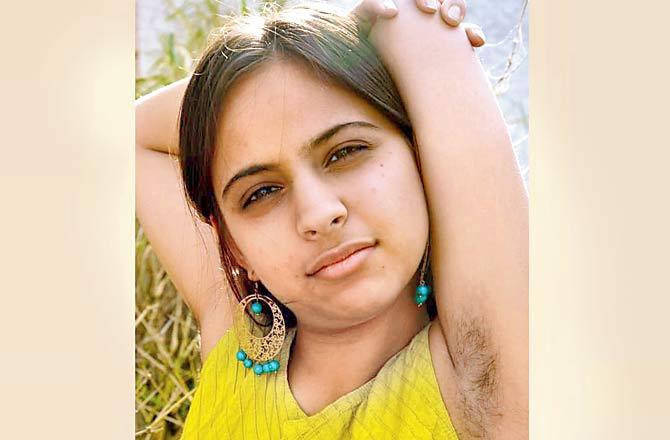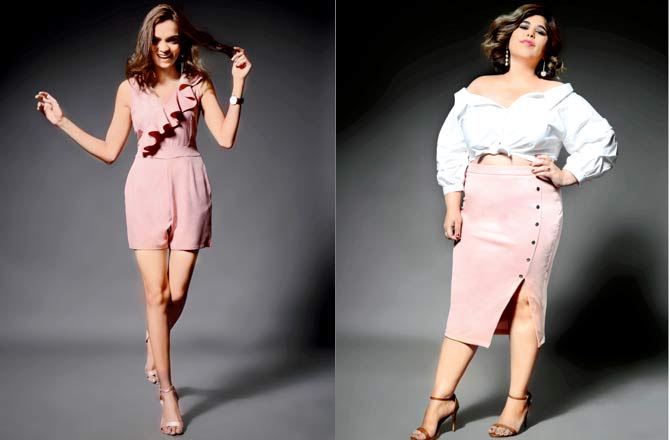The era of Kate Moss-esque models is over. With consumers looking at the story behind the face, the stage is now ready for women of all shapes, sizes and colours to become the new beauty role model

Neelakshi Singh, 27, is a plus-size model who posts under the Insta handle @Plumptopretty. In 2014, she started embracing her weight and began questioning standards of beauty and why someone her size couldn't feel beautiful
To the child of the 90s, beauty was defined by the Miss Indias — Aishwarya Rai's perfect face, Sushmita Sen's tall frame, Diya Mirza's peaches-and-cream complexion. The short, curvy and dusky couldn't hope to think they were beautiful. Cut to 2018, where a leggy Deepika Padukone with her impeccable make-up and styling, is the ideal many want to aspire to, but thanks to social media, there is also a more realistic 'beauty role model'. She is the Nodel (Not The Model), a word coined in 2016 by author Karley Sciortino, who wrote the beststelling Slutever about her multiple sexual experiences, when she (a healthy size 6) landed two Kate Spade New York's campaigns.
ADVERTISEMENT

Actor Rytasha Rathor in a PA.NI swimsuit which she flaunted on her Instagram
Call her Nodel, or call her Real Girl. But it seems that for the first time in fashion history, women with their own distinctive looks and sizeable social media following are not just inching their way into fashion and beauty campaigns, but, more importantly, giving "the regular woman" hope that being who we are is enough to classify us as beautiful. As Sciortino told magazines at that time, "In the age of social media, we don't look at people because they're pretty — we look because we're interested in them, because we want to follow their story."

A picture from photographer Anushka Kelkar's Instagram account @browngirlgazin, which talks of their relationship with their bodies: "Waxing is time consuming. I don't wax or shave most of the times because there are things more important than satisfying someone else's standards of beauty. I love my body. Hair is natural and I am comfortable with it. I was taught not to be.... but oops! At times I find myself conforming to European standards of beauty. I realise how ingrained it is in our minds. I have to take a step back to say” no". My present body is not my ideal body. My ideal body is stronger."
That pretty feeling
It was in March 2014 that Neelakshi Singh, now 27 years old, first started uploading images on Instagram. In a few weeks, Singh, who fits into a UK size 16 started using the hashtag plumptopretty. The handle, @plumptopretty (which now has over 10k followers), has over the last four years been her platform to assert that women can feel beautiful and participate in fashion no matter what their size. And, in 2017, when Lakme Fashion Week, the country's most followed ramp show, held its first plus-size event, Singh was among the first to walk. A regular ever since, she recently walked the LFW ramp for retail brand Half Full Curve. Singh says even though it's taken some time to get here, she's glad that India is finally taking a cue from the West.

The FabAlley campaign has decided to use the real girl of all types - curvy, dusky, skinny and curly haired, amongst others. Their tag line is "Fab fits all".
"We are in the middle of a culture shift right now. The ideal body type has already changed. It's all about being an 'individual'. You can't define this era in the way we defined the 20s, saying oh ya, flapper style. For 2018, there are no tags. Everyone is just being an individual," says the curvaceous beauty with pink hair. Rixi Bhatia, founder of Half Full Curve, who got Singh to walk for them, says she thinks that there is no "new" real girl. They are now flaunting their confidence on social media, and hence, are being noticed. "We get people who come to us, who have never walked into a retail store before, because they just don't get their size. But now, they see all these ladies, flaunting their non-traditional beautiful bodies in swimsuits, and dresses, and they want to do the same too," says the Mumbai-based fashion designer.

Fashion blogger Prachi Kapoor, lifestyle blogger Monalisha Mahapatra, and digital editor Spardha Malik
Buying into the story
Kate Spade explained their 2016 decision to choose Sciortino with: "Karley is a powerful, feminine woman who possesses a sense of curiosity, intelligence and strength. In our campaign, she does what she does best: she is herself." It's a philosophy that brands outside of New York are buying into. When PA.NI Swimwear launched their line early this month, they opted for influencers like actor Rytasha Rathore, singer-songwriter Mali and activist-poet Aranya Johar — all varied in shape, size and colour — to flaunt their swimsuits. We felt a warm glow when we read their tagline "perfect to show off those love handles".

Leila Veerasamy
The 25-year-old founder of the brand, Leila Veerasamy, who grew up in Mauritius, says she started realising that there were no swimsuits for curvy women. She started the brand to offer a choice. "I think this change has taken 25-30 years to come, and so it will last. When brands make this shift, it means a change in logistics, and they won't go back on that. Asking influencers to be a part of this was the best way to show the range of swimsuits we have." Rathore, one of the nodels, flaunted the swimsuit on her social media account. She says that a "real girl" is just someone who doesn't subscribe to traditional beauty standards.

Meghna Pant
"I think everyone is realising that we [women] have more to offer than just looks, and that's what works," says the 25-year-old. The rise of the "real girl" could also be attributed to the fact that they are just like us, and if something could look good on them, it could look good on anyone. It would then seem that being "relatable" is their biggest draw. The curvy Spardha Malik, online editor for a fashion magazine, who recently appeared in a campaign for retail website FabAlley, says she is "super glad we are having this discussion".
"Paris Fashion Week is doing it, and so are we now. It will soon start changing at store level too. With FabAlley, I loved that they got five women who were different in every way — height, colour, hair and size. Brands realise that the need of the hour is inclusivity." Tanvi Malik, co-founder of FabAlley, adds, "We understand the pressure everyone is under, and we know everyone is struggling to find their fit — so we covered every spectrum — height, skin colour, professions and ages. Inclusivity and diversity are not going anywhere."
The pressure to be real
And then, are we trying too hard to be real? Singh says she now faces the other struggle with her image — the audience doesn't want her to change. The curvy, coloured-hair look has become far too synonymous with her. "It's a real conflict with my inner self. If I change my hair colour or try and lose weight, that's a no no, because I may stop being the real girl I am. I feel I have to constantly keep up with this image. I get my hair coloured every 15 days, and if I even put up one post about eating healthy, I get tonnes of messages against it. But that will also be me, right? [Even if I lose weight] I will still be the real girl."
Photographer Anushka Kelkar, who started @browngirlgazin, after she was told to lose weight at college, makes it a point to feature women and their relationship with their bodies and skin colour on her account. "I was annoyed by my own feed where we only saw perfect girls put up bikini pictures. But then when I started photographing girls, I realised I had my own bias. I thought 'being real' was about being unconventional — maybe curvy, or dark skinned. But then I realised that even really beautiful women are not comfortable with their bodies or skin," says the 22-year-old who now works at a design firm. Today, her account carries the tag: making more honest portraits of people who identify as women, their relationships with their bodies and redefining beauty'. "To me, a real girl is one who knows that it's not about the body you have, but how you inhabit it."
Her feed now has women battling acne, the stereotype of only-straight-hair-is-sexy, a chest size that doesn't fit into a swimsuit body, body hair or even stretch marks. There's also the woman everyone hates — the skinny b***h sharing her story of popping pills to increase her appetite and fit another mould entirely.
"We have to stop encouraging 'fat talk'," says author Meghna Pant, whose latest book Feminist Rani is about powerful women talking about gender equality. "Instead, encourage intelligent talk. Get new ideas of physical representation. Role models need to be women who are turning problems into solutions, ruling their world, and kicking a** every day, in different shapes and forms! Talent matters, not your size."
But at the end of the day, why do looks even matter, feels Vibhuti Patel, professor at the advance centre for women studies at the Tata Institute of Social Sciences. As she puts it, the "real girl" is just perpetuating the homogenization of how women should look all over again. "These real girls are the consumers of the fashion and beauty industry, and so, they are catering to them by using these 'real' models," she says.
The professor says that gossip and conversations she hears at events or even trains is all about brands, not about utility. "I was just at a conference in Malaysia, where I was talking about political feminism, but people are more concerned with the 'dress code'. How does that even matter? It's about keeping women on their toes, about if what they are wearing is acceptable. Why not just let women be as diverse as they can?"
Catch up on all the latest Mumbai news, crime news, current affairs, and also a complete guide on Mumbai from food to things to do and events across the city here. Also download the new mid-day Android and iOS apps to get latest updates
 Subscribe today by clicking the link and stay updated with the latest news!" Click here!
Subscribe today by clicking the link and stay updated with the latest news!" Click here!






